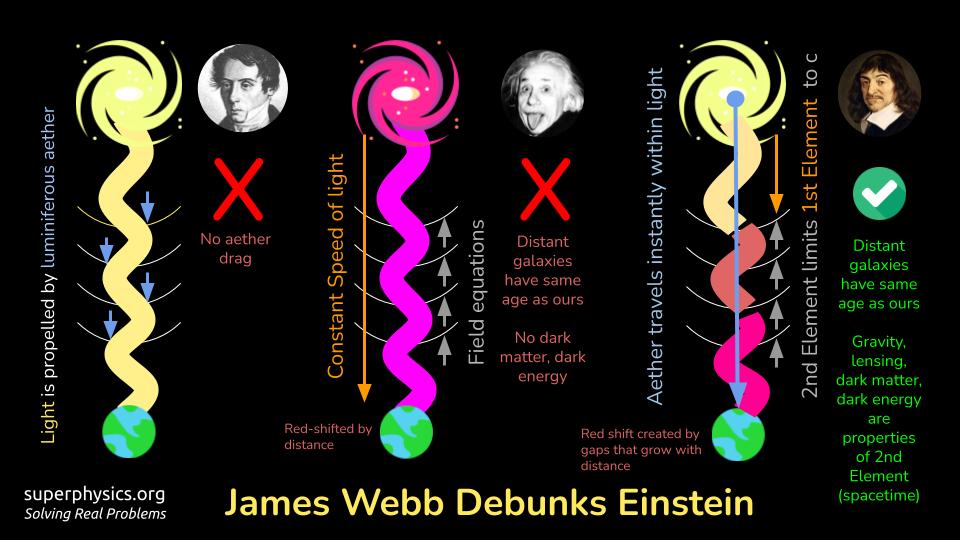Replacing Einstein's Relativity with Poincare's Law of Relativity
Table of Contents
In a previous post, we mentioned how Poicare’s Law of Relativity can replace Einstein’s Relativity in order to restore the proper understanding of Nature. This will then lead to new spacetime technologies.
But how does Einstein’s Relativity trap humans on Earth without those new technologies?
The History of the Aether
In the 18th century, the wave-based nature of electromagnetism and of space were not well understood.
In 1816, Augustin Fresnel presented his wave theory which eventually became the luminiferous aether hypothesis.
This said that space had an invisible energetic (elastic) aether that propelled light and gave it wave properties. This was also eventually adopted by Maxwell.
Since this propulsion was directional, then there should be some drag from the opposite direction as to change the speed of light and make it variable.
- This variable speed of light is consistent with Descartes’ Physics.
However, the Michelson-Morley experiment later revealed that the speed of light was constant everywhere and in all directions.
- Before this, it was thought that space was constant and light was changing.
- After this, physicists realized that space was changing and light was constant.
This prompted Lorentz to create length contractions (1892), and Poincare to create the Law of Relativity (1902) in space.
Poincare’s Law of Relativity is based on a body’s current state compared to its initial state and the current states of other bodies, all referencing the current absolute state of the system.
This is consistent with:
- Descartes’ Rule 1 of state-change (since the Cartesian aether is arbitrary)
- Descartes’ assertion that movement comes from the initial spin (vortex rotation) or state of the particle
- the spin of Quantum Mechanics
Einstein Messes Up Physics
For some reason, Einstein comes out of nowhere in 1905 to hack Poincare’s Law of Relativity.
He enshrines the constancy of the speed of light and uses it as a measure of both space and time, disregarding Newton. This is wildly different from Poincare who allowed different times:
- Newtonian time
- Electromagnetic time
- Mental time
This flexibility of time is why Poincare wrote:
We have not a direct intuition of the equality of 2 intervals of time. The persons who believe they possess this intuition are dupes of an illusion.
Henri Poincare
The Measure of Time
But Einstein duped everyone and locked space and time to light anyway. This led to E=mc^2 where m is really electromagnetic potential in active particles, and not Newtonian mass in static inertial ones.
This is why E=mc^2 works for uranium, but not for iron.
This led to nuclear fission at the expense of nuclear fusion which requires anti-gravity which is impossible under Einstein, but possible under Poincare.
Poincare’s Law of Relativity Matches Quantum Mechanics and James Webb Space Telescope
In Cartesian Physics, the speed of light varies in every star system dictated by that star’s vortex.

- Light is 300,000 km/s because that is how the sun wants it.
- An atom has a certain number of electron shells (different from other atoms) because that’s how its nucleon wants it.
The electron has to follow those shells imposed by the nucleon’s territory just as light has to follow the speed imposed on it by the star’s territory.
To Einstein, the speed of light is constant EVERYWHERE. So it means that light from a distant galaxy 1 million light years away is 1 million years old.
But to Descartes, that light is at the current age.
For example, if your friend in Berlin starts a Zoom meeting at 9:00 pm Berlin Time, then you at Tokyo will start it at 4:00 am.
A lag of 1 second in the Zoom signal does not mean that Berlin started its meeting late by 1 second.
-
An Einsteinian would argue that if the lag were 1 hour then at 5am you would see your friend’s state at 9pm Berlin time (4am your time). You would be seeing a past or 1-hour younger version of your friend!
-
A Cartesian would reply that such a lag would mean something unnatural was blocking the signal, causing it to float in limbo for 1 hour.
But space telescopes see the light from distant galaxies continuously and not twinkling nor disrupted. So there should be no, or very little lag, in its information.
When we look at the stars, they do not seem “choppy” or change suddenly in size and color.
In reality, a laggy zoom meeting shows the current version of your friend but in a paused, choppy state.
This is why the James Webb Space Telescopes (JWST) shows all distant galaxies as having nearly the same look as ours, instead of being at their infancy. This is because they are also of the current age, not of a distant age.
The problem is that physicists have been conditioned to think that Einstein was a genius. And so they would rather concoct wacky new theories on early galaxy formation to match the data from JWST rather than the more common sense solution of dropping Relativity.
Einstein’s Relativity Must Flushed Out From the Study of Nature
The total refutation of Einstein’s Relativity is essential not only in matching the findings of JWST and Hubble. It is also needed to harmonize Classical Mechanics with Quantum Mechanics through the Cartesian Aether as a ‘Grand Unifying Theory’.
This unification will create the anti-gravity that is needed for nuclear fusion and space travel that is superior to nuclear fission and Newtonian rockets respectively.